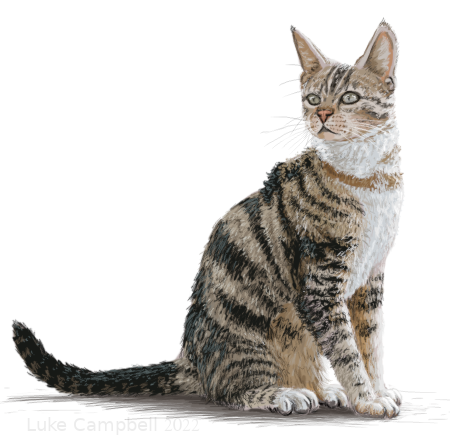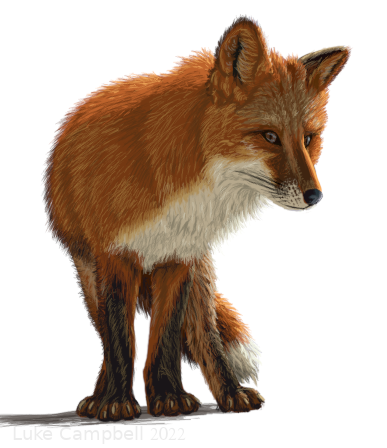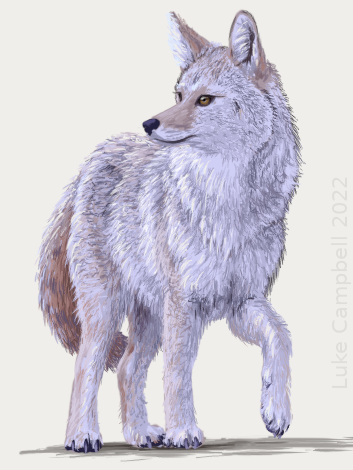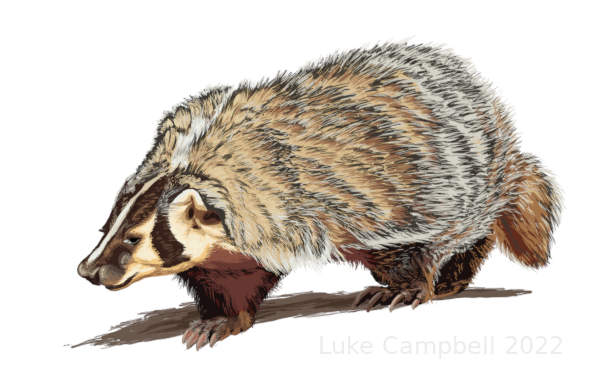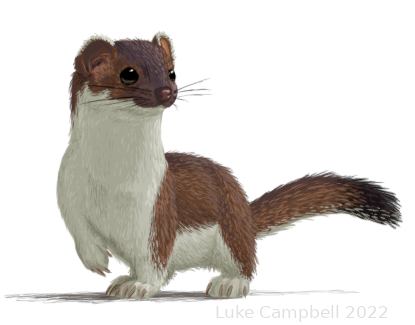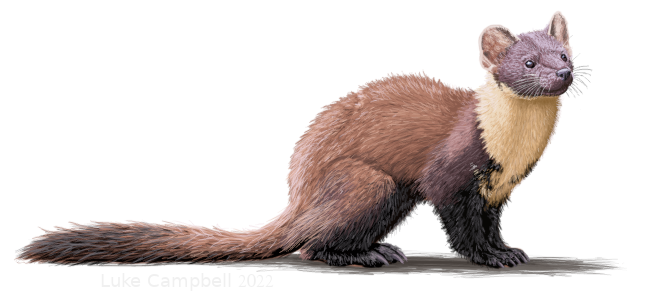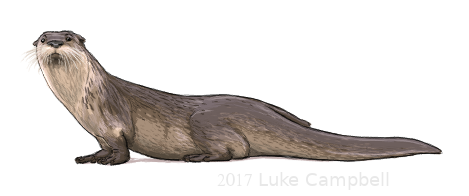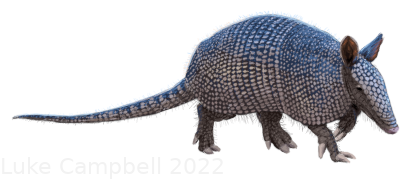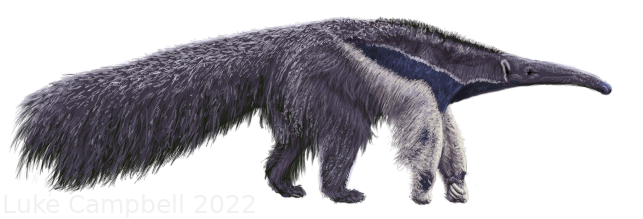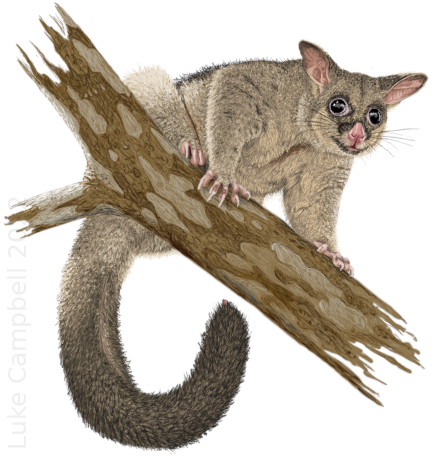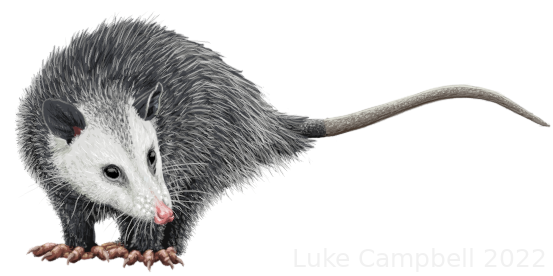| San Agustín Field Guide | |||
|
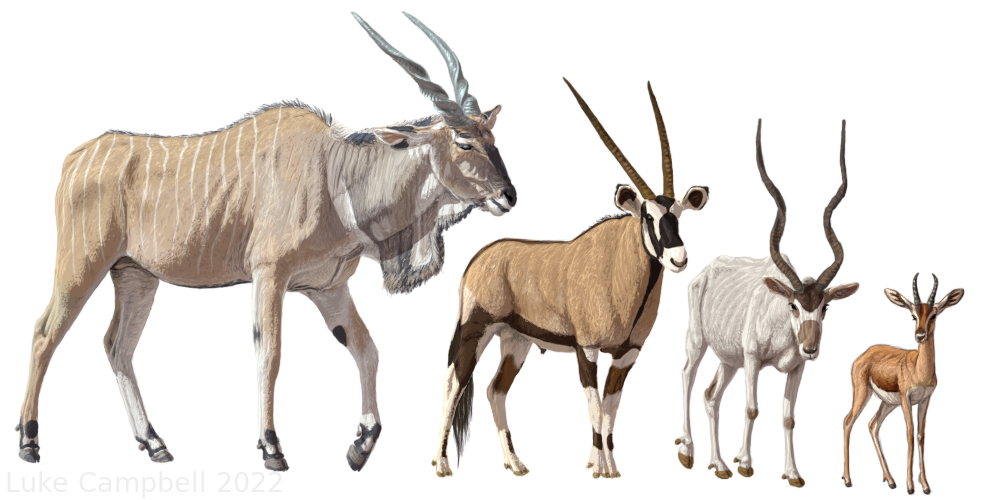
Giant elands are large antelope with robust bodies, humped shoulders, and spiral horns. They inhabit dry, open areas such as scrub, grasslands, woodlands, and near deserts where their keen senses allow them to detect danger from far away. Elands are active primarily in the morning and evening, and both browse and graze. Eland are found in herds numbering in the hundreds. Often, several males will accompany a herd of females. Young elands will typically form herds with others of their own age. San Agustín is home to three species of oryx; the scimitar oryx, Arabian oryx, and gemsbok. These mid-sized antelope are strikingly colored with black and white markings. They have long horns, with those of the gemsbok and Arabian oryx straight while the scimitar oryx has horns that curve back in a slight arc. These horns can be dangerous weapons, and a threatened oryx can use them to impale its attacker. Oryx are creatures of the desert, and can obtain all the water they need from the food they eat although they will drink if given the opportunity. Like the oryx, the addax is a desert antelope, and does not need to drink. Addaxes tend to be rangy, gangly beasts with large hooves and spiral horns. Three species of gazelle can be found on San Agustín; the rhim gazelle, dorcas gazelle, and dama gazelle. Gazelles are small, dainty, and agile antelope known for their high speed and nervous disposition. They are browsers, selecting easily digestable parts of plants. Gazelles are usually found in large herds, which keep a wary eye out for predators.
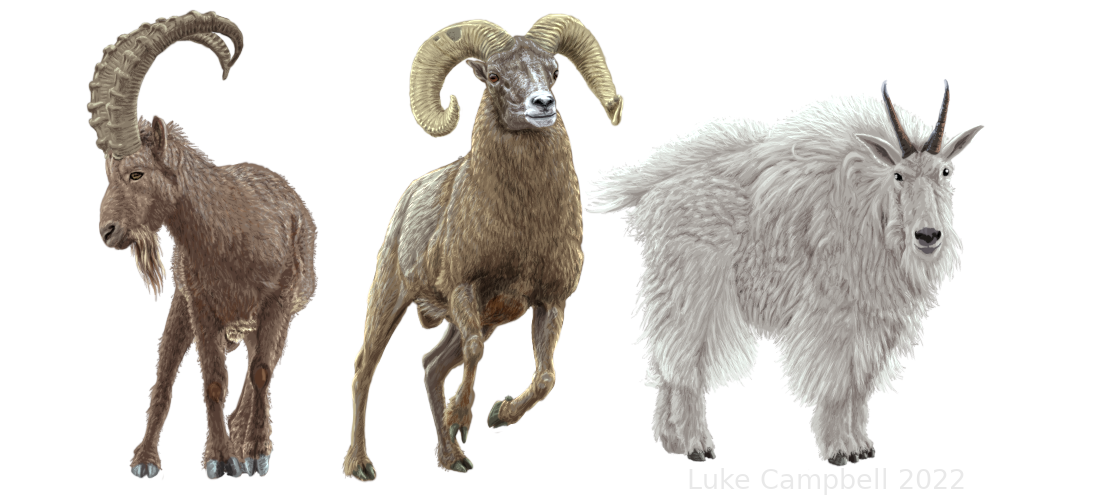
Wild caprines are agile and hardy animals that live in rugged, rocky, precipitous terrain. They often dwell on sheer cliff-sides, and can run up and down rock faces that are inaccessible to most other animals. Females and their young live in herds, males are typically solitary outside of the mating season but may be found in small bachelor herds. All caprines of both sexes have backward-curving horns. The horns of the males are larger and can be spectacular. They use their horns in vigorous head-to-head ramming contests to establish dominance. They are usually eager to bash anything nearby with their heads. Females' horns are much smaller. The three wild San Agustín caprines are the Siberian ibex, the desert bighorn sheep, and the mountain goat. Ibex are primarily browsers, selectively eating the tips of shrubs and trees, vines, and leafy forbs. They can thrive on even sparse and coarse vegetation due to their broad diet. Males have long tufts of hair - beards - on their chins, and have a rank smell. Bighorn sheep tend to dwell at lower elevation, warmer temperatures, and drier climates than the other San Agustín caprines, although they still prefer cliffs, steep slopes, and rocky areas. They both graze and browse. The huge curling horns of the males can make nearly a full circle in breeding adults. Mountain goats, while still caprines, are not true goats. They are white and very wooly inhabitants of high elevetions and cooler temperatures, generally above the tree line. Unlike many other caprines, the horns of both males and females are relatively modest sized and spike-shaped. They are primarily grazers munching on the carpet of grasses, moss, ferns, and lichen that covers the ground. Mountain goats can be very agressive – they are bad tempered and will often stand their ground and fight if threatened. The females spar and scrap over dominance in their herd, and will not hesitate to gore any threats to their offspring. The males, of course, battle each other for mating rights as with other bovids.
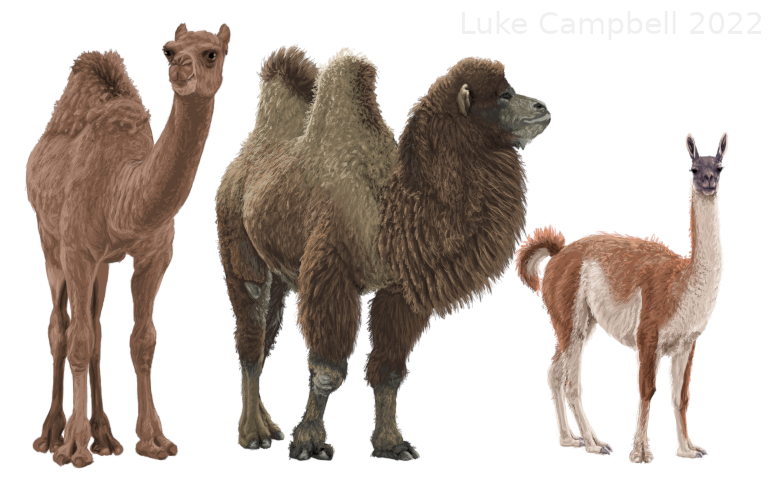
Dromedaries are a species of domestic camel that has gone feral. This species has a single hump on its back that is used for fat storage. These camels are well adapted to live in harsh arid climates. They can go for over a megasecond between drinking, can survive up to 30% water loss, and can make do with brackish water when they do drink. It is adapted to tolerate high heat, allowing its body to super-heat while keeping its brain cool enough to avoid death. Dromedary nostrils can seal shut to keep out wind-blown dust and sand; long eyelashes provide a similar function for the eyes. Their main diet is thorny desert plants. The wild camel has a similar appearance to the domestic Bactrian camel, but is a separate species. It has two humps on its back for fat storage, and thick, shaggy hair. Like the dromedary, the wild camel is adapted to harsh desert conditions, but can tolerate colder temperatures and temperature swings from well below freezing to over 50°C. They can eat snow for water, and are one of the only mammals that can directly drink the hyper saline water of San Agustín's seas. Their nostrils can be sealed shut as protection against blowing dust and sand and a double row of long thick eyelashes to protect their eyes. Their primary food source are desert shrubs. The guanaco is the smallest of San Agustín's camelids. They have a wide range of habitats, including steppe, scrub, and alpine areas. Less desert adapted than other camelids, they can nonetheless survive in even the most arid regions if given regular access to water – such as drinking fog and dew. They are grazers and browsers, eating grasses, lichens, fungi, and cactus. Guanacos can tolerate high altitudes, and are often found on the continental slopes well above the tree line.
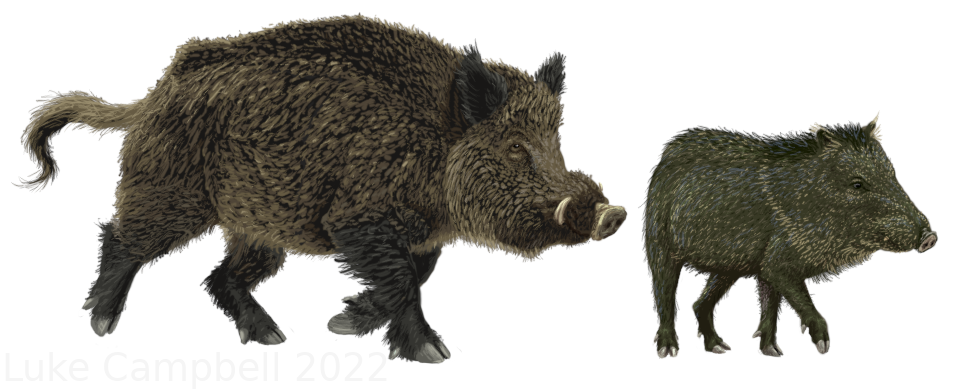
San Agustín has two species of wild swine. Javelinas, also known as collared peccaries or musk hogs, are a small variety of swine. They are by far the most common variety of wild swine encountered on San Agustín. Javelinas are cosmopolitan animals that make use of a broad variety of habitats, including drier lands such as deserts and scrub that is common to San Agustín. They make their homes in burrows, under the roots of trees, caves, and under logs. Javelinas are usually activde during the day, but will sometimes come out at night as well. When scared, they will release a strong scent and may give a barking sound. Feral pigs are the offspring of escaped domestic pigs. They require thick vegetation for cover, and so are restricted to the wetter areas along rivers and the continental slopes. Pigs will make simple nests by cutting grass and spreading it into a mat. They then crawl under the mat for shelter. They are fond of wallowing in mud. Pigs are mainly active at dusk, dawn, and at night. When young, feral pigs are striped; as many as a dozen piglets can be seen following their mother in their herds.
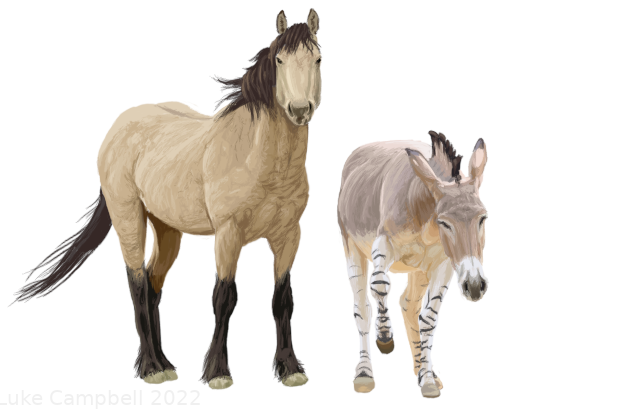
Both species on San Agustín are found in groups of one stallion, several mares, and their young. The mares stay with the group throughout their lives, stallions are replaced when they can no longer fight off rival stallions. The group is led by a single experienced mare. The group usually travels single file, following the lead mare with the stallion bringing up the rear. Stallions that are not associated with a group of mares group together in bachelor herds of a few animals, with a similar social structure. Feral horses are found in the plains and scrub-plains downwind of major seas where sufficient grass can grow to support them, as well as the lower reaches of continenta slopes with sufficient rainfall to support grasslands. Hybrids of feral donkeys and wild asses tolerate the much more abundant desert and semi-desert environments common to the San Agustín lowlands and less well watered continental slopes and highlands. These wild donkeys get most of the water they need from the coarse vegetation they subsist on, although when their diet is dry they need supplemental water (which can include brackish water). They are tough, hardy creatures that have adapted well to San Agustín's harsh environment. 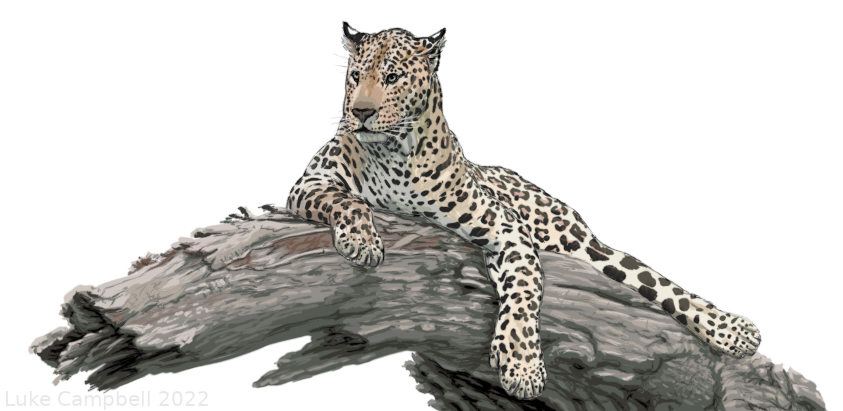
Three species of cat are common on San Agustín: the housecat, the bobcat, and the leopard. Of these, housecats are the most frequently seen. They are commonly kept as pets by Humans, and are often allowed to spend considerable time outdoors coming and going as they will. In addition, many feral populations of housecats have been established. Housecats are the smallest of San Agustín's cats, and prey upon various small animals, ranging from rodents and birds to small lizards and insects. Bobcats are adpatable wild cats intermediate in size between housecats and leopards. They are notable for their short tails and the long tufts of hair at the tips of their ears. They will eat a wide variety of small prey, including rodents, rabbits, hares, songbirds, lizards, pheasants, grouse, and turkeys. Leopards are the largest cat common to San Agustín, and are easily identified by their spotted coats. They prey on large animals, such as boar and antelope as well as the occasional domestic animal like dogs or cattle. Leopards are adept climbers, and are frequently seen lounging high in the boughs of large trees. They have a curious habit of dragging its prey up into the branches.
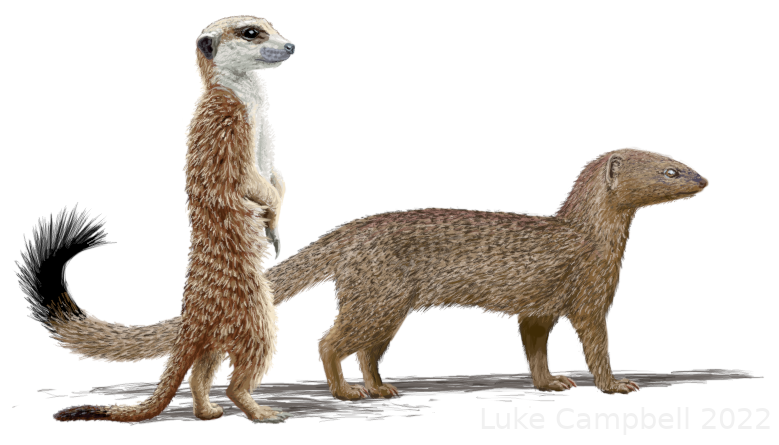
Slender mongooses are lithe and solitary hunters. Diurnal, they will often climb trees in pursuit of birds but are primarily terrestrial. As befits a true mongoose, they often prey on venomous snakes. They are found in a wide range of habitats, from forests and scrub to plains and arid lands. Meerkats are found in arid, open habitats. They are highly social animals, foraging in groups of between two and thirty individuals. One pair is dominant; they form the nucleus of the group and are the only meerkats in the group to breed. The other meerkats help to care for the young. Meerkats are good burrowers, and excavate a nest of twisting tunnels in rocky areas. During the day, meerkats forage widely in their territory for insects and scorpions – along with the occasional egg or small vertebrate. At least one individual will be on watch at all times, ready to sound the alarm if danger appears. The foraging meerkats trade off on this watch duty to allow all members to find food. Meerkats are highly territorial, and will fight viciously with meerkats from other groups. However, they often share their burrows with animals from other species, such as ground squirrels or other herpestids or mustelids.
In addition to feral domestic dogs, two wild canids are found on San Agustín: red foxes and coyotes. Both primarily take prey smaller than themselves, and are known to be fast, cunning, stealthy, and adpatable. They adapt well to urban environments, where they scavenge trash and catch small urban animals (including, in the case of coyotes, the occasional cat). The red fox is the smaller of these canid species. They usually have red-oragne fur, but may range from grey to silver, black, or brown, often with a darker stripe along the spine. They have a distinctive musky odor, and can use their musk to mark territory or leave "stink bombs" when upset or frightened. Coyotes are the larger wild San Agustín dog, and will occasionally hunt in small packs to catch some of the smaller antelope species. Coyotes keep in touch with other members of their pack with their eerie yipping howls, the same howls also helps to warn other packs off their hunting territory. Coyotes and badgers often team up to hunt together; the coyote scares prey down into their burrows, badgers flush them back out again, leaving nowhere for the prey to hide.
The dirt weasel is the American badger, a stocky animal with distinctive black and white face markings and the powerful front legs and large shovel-like claws that make it such an accomplished digger. Badgers make a living digging up prey animals in their burrows. They will also eat carrion, and have a habit of burying large carcases to protect them from other scavengers. The tunnel weasel is the long-tailed weasel, a tiny carnivoran with a long flexible body that enters the burrows of its prey to kill them in their dens. Although most of their food is made up of small rodents, long-tailed weasels are known for occasionally killing prey much larger than they are such as rabbits or seagulls. If given the opportunity, long-tailed weasels will kill far more than they can eat immediately, and stash the remainder away to consume later. The tree weasel is the pine marten. This agile animal scampers up trees and leaps between branches. Much of its diet is composed of squirrels and birds. The San Agustín population of pine martens has become adapted to urban habitats, where they make homes in parks and backyard trees. The water weasel is the Canadian river otter. Powerful swimmers, they can be spotted moving in small groups through rivers and lakes, foraging for fish and shellfish. Many river otters carry some lontra genes, making them more intelligent, more dextrous with their forepaws, and friendlier toward people.
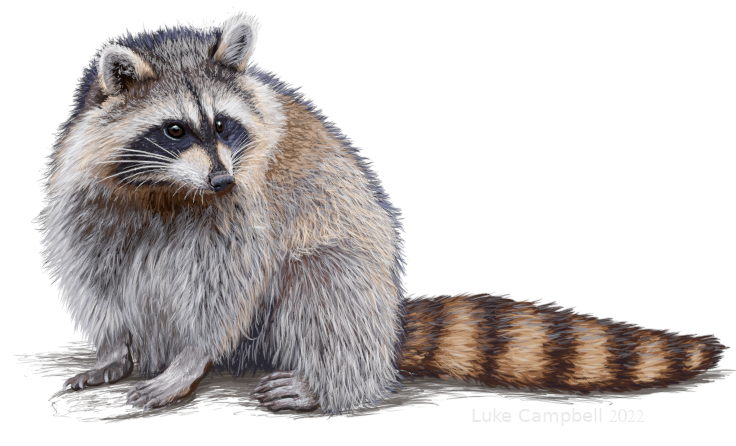
A small but growing population of coatimundis (or "coatis") can be found in the tropical regions of the northern scrub. Coatis are mid-sized omnivores that forage in large family groups. Meanwhile, ringtails are expanding into the desert scrublands of the interior, although these reclusive nocturnal animals are rarely observed. Ringtails are omnivores with a carnivorous bent, supplementing their diet of rodents, birds. reptiles, amphibians, and insects with berries, juniper, and cactus pads. They are long bodied and agile animals, and become easily habituated to nearby sapients – those making their homes in rural desert areas may find a ringtail taking up residence near their home to feed on the rodents attracted to the food, water, and shelter.
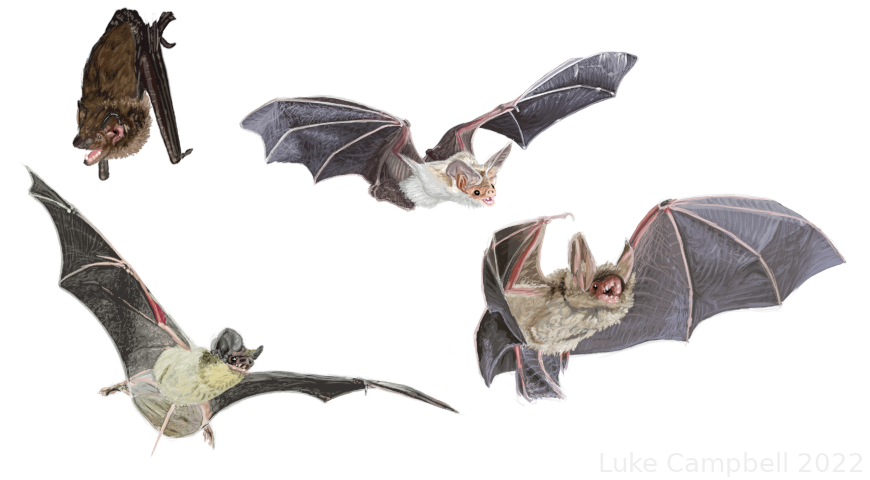
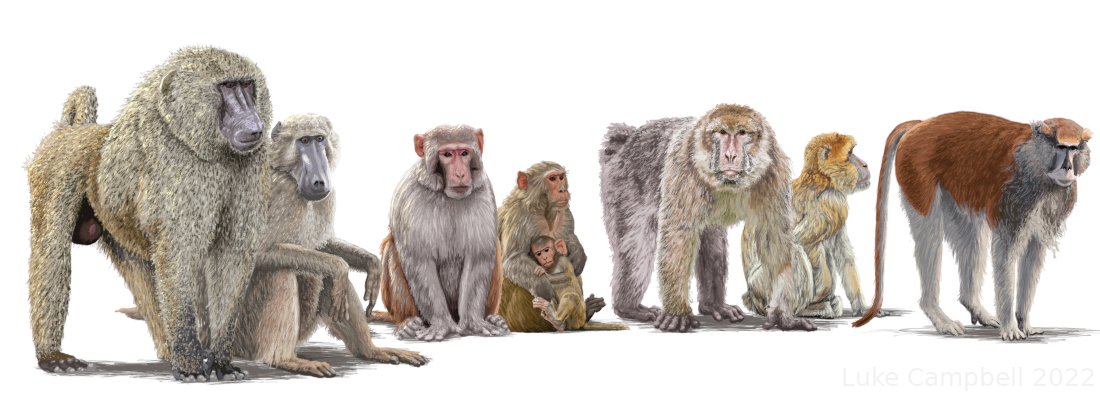
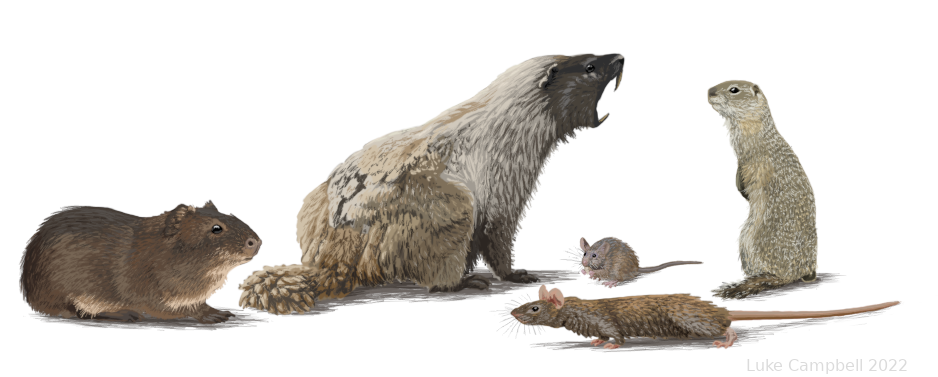
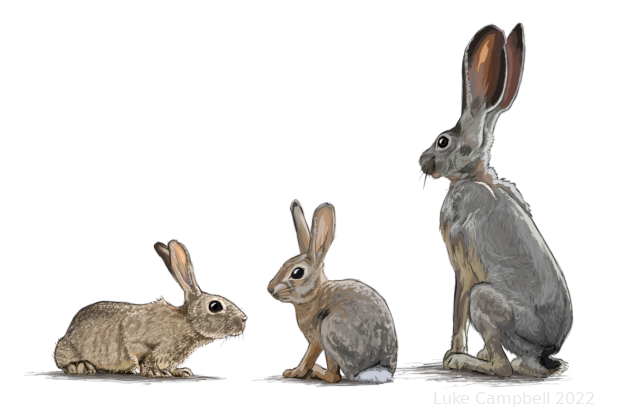
The desert cottontail is a rabbit that, while tolerant of other cottontails, is not particularly social. They live in burrows made by other animals, although they will also rest in shallow scrapes made in the ground. Cottontails mostly eat grass, with the occasional twig, leaf, scrap of bark, cactus, or fallen fruit. They rarely need to drink, as they get most of their water from their diet and from morning dew. Their young are born in a burrow, helpless and with their eyes closed. The European rabbit is a highly social rabbit. Their colonies dig extensive warrens, or networks of tunnels, to live in. They prefer to live in short grasslands with cover near feeding areas, with well-drained soil so their warrens do not flood. they primarily eat grasses, although they will take other vegetables and leaves. European rabbits give birth to large litters of helpless young in burrows separate from the main warren; they can get around on their own after 1 – 1.5 megaseconds, and are mature at 10 megaseconds.
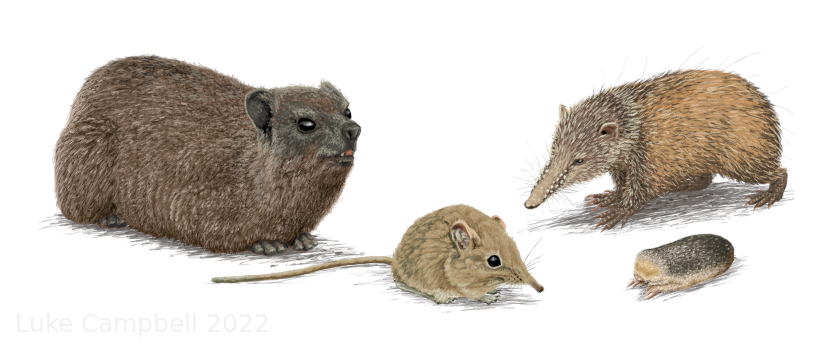
The rock hyrax, or dassie, is a common resident of rock outcrops where they live in groups of several dozen individuals that forage for plants up to 50 meters from their home. Some will keep watch, and sound the alarm if danger appears. Dassies have unusual tusk-like front teeth and the feet have large pads that help them cling to rock faces. Several species of sengis, also called elephant shrews, have been introduced. These are fast-moving small animals with long legs and an elongated snout. They feed on small invertebrates. A number of tenrec species have established populations. The most commonly encountered is the tailless tenrec, which is also the targest tenrec species. It has a long snout and spiny hairs, lives in burrows that it digs, and eats a variety of small animals ranging from insects, spiders, and worms to mice and frogs as well as fruit and vegetables. Tailless tenrecs can hibernate for extraordinarily long periods of time – over 20 megaseconds – to wait for favorable cliactic conditions. The golden moles are burrowing animals that spend almost all their lives below the ground. They lack external eyes and have no obvious ear opening, but have very powerful forelimbs and large shovel-like claws for burrowing. One species lives only in sand, through which it swims as it searches for food by the vibrations of its movement. Other speices live in soil in which they construct networks of tunnels. The main diet of all golden moles is termites, although they will eat other insects and even small reptiles.
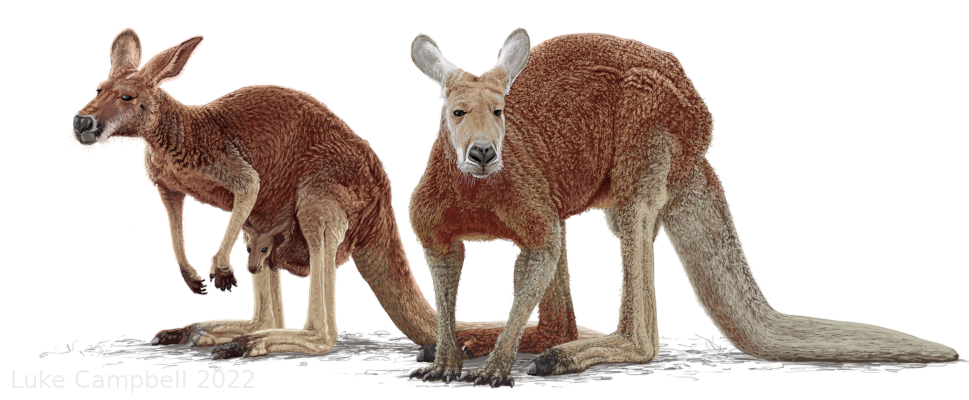
At one time, several populations of black-flanked rock wallabies existed on San Agustín. However, with the expansion of carnivoran predators into their former range, these wallabies are now uncommon. Many of the original populations are now locally extinct, and others are greatly reduced and shrinking.
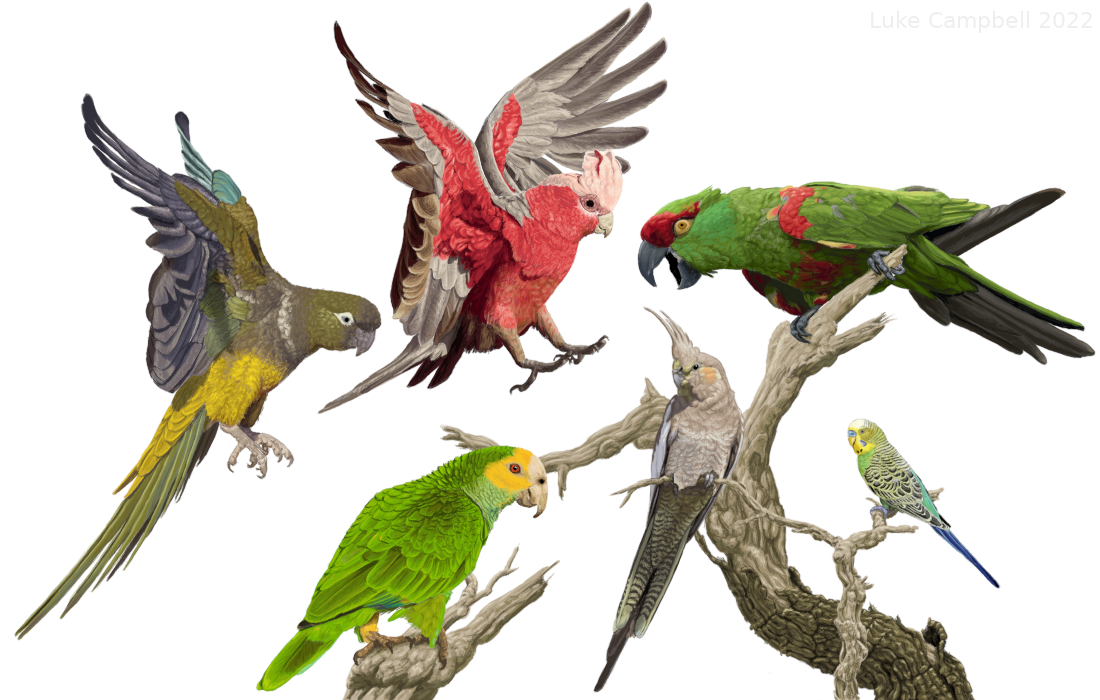
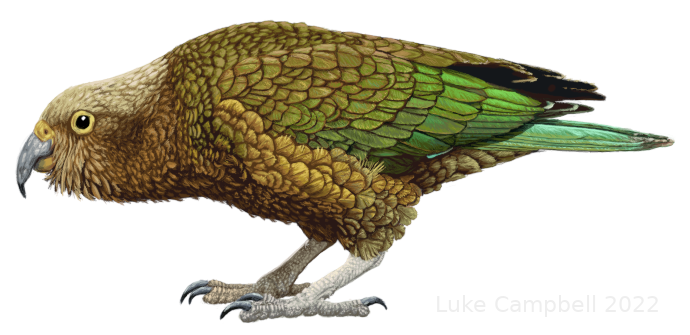
Patagonian conures, also known as burrowing parrots, are an arid land parrot species that is notable for digging burrows in cliff faces for nests rather than relying on pre-existing tree hollows. They can even dig into soft rock like sandstope or limestone. They are green-grey about the head and shoulders, grey-brown chest and neck, a light colored collar mark, with yellow legs and rump, a red patch on their lower abdomen, bright green-blue on the upper part of their flight feathers, and a white ring of bare skin around their eyes. They prefer dry, open habitats near water sources. Galah cockatoos are striking pink, crimson, and grey birds. They live in open habitats with scattered trees or brush, and thrive in urban areas. The crest of feathers on their heads indictes their emotional state – raised if excited or surprised, or flattened when scared or angry. Cockatiels are small parrots, found flying in moderate sized flocks around San Agustín's arid and semi-arid lands, usually close to water and often in scrub or brush. They are nomadic, moving with the availability of food and water. Like galahs, their head crest indicates their emotional state. Yellow-shouldered amazon parrots are bright green birds with yellow markings on their faces and wing-shoulders. They are commonly found in scrublands and dry forests. Thick-billed parrots are green birds with a red face mask and red and yellow feather patches elsewhere on their bodies. As their name suggests, they have particularly powerful beaks. They are generally found in dry forests at high altitudes, and can tolerate cold temperatures and harsh winter weather. They primarily eat the seeds of pines and other conifers, but will occasionally also take other nuts such as acorns. Their calls are reminiscent of Human laughter. Budgerigars, also called budgies and parakeets, are small parrots. Their wild-type coloration has a green belly, yellow and black markings on the head, back, and wings, and blue tail feathers. However, as the population on San Agustín is descened from animals in the pet trade, many of San Agustín's budgies lack yellow pigments and thus have blue in place of green and white in place of yellow, with the occasional white and black or pure white individual cropping up. Budgies are found in huge flocks living in open scrub and woodland near water sources. They feed primarily on grass seeds, and can be a pest when they consume cultivated grains. Keas are large mountain parrots known for their inquisitiveness, clownish antics, and destructiveness toward anything they can pry apart with their beaks. They are more omnivorous than most parrots, and predate small animals and scavenge carrion in addition to digging for roots, nipping leaves, pluching berries, and sipping nectar. They have drab coppery to olive green plumage; but in flight reveal brightly colored red patches underneath the wings, a red rump, and irridescent blue-green flight feathers.
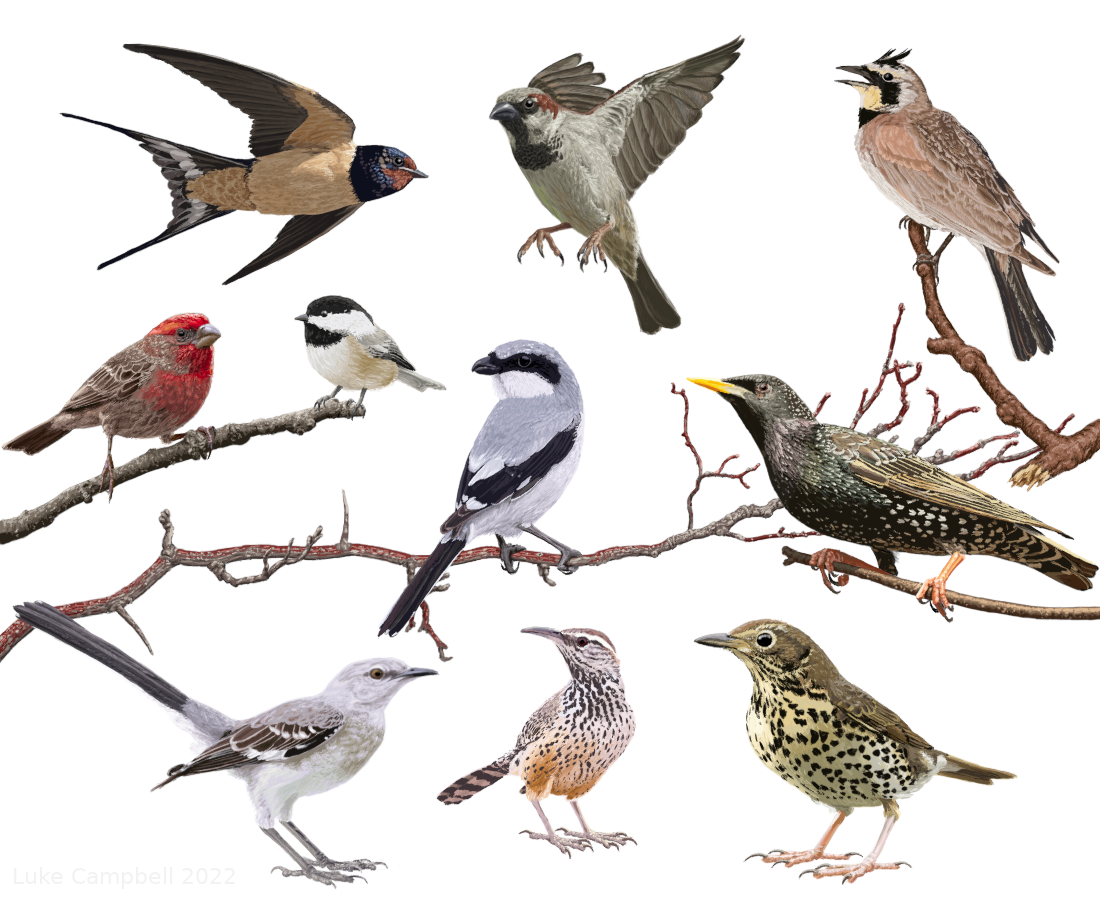
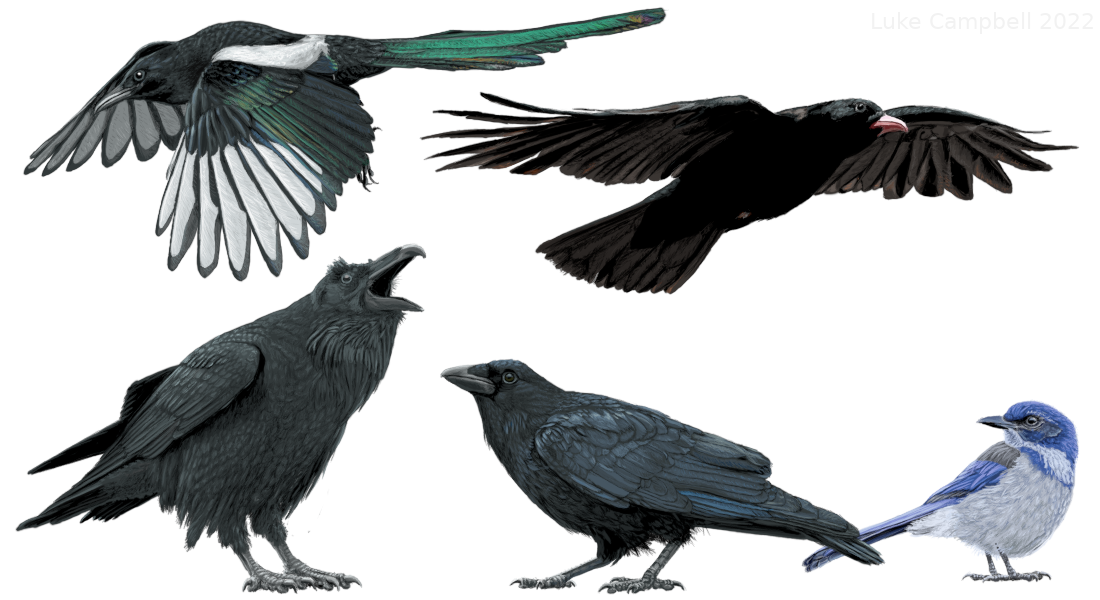
Magpies are strikingly colored black and white birds, with a chattering call. They can be found in a wide range of habitats, including urban areas, but require trees for nesting. They often associate with large herbivores, picking off ticks and other parasites. Red-billed choughs are black birds with a bold red-colored downward-curved beak. They are highly acrobatic fliers. They are primarily found at high elevation. They nest in caves or fissures in cliffs and crags, or occasionally in old buildings, mineshafts, or quarries. The main component of their diet is invertebrates, particularly ants, which are preferentially foraged in fields with grass grazed short by herbivores. Ravens are the largest of the corvids, with a jet black color. These birds will predate small animals, plunder nests for their eggs, and scavenge at carcasses. They often gather around the kills of large carnivores, waiting for a chance to snatch a tasty morsel.Ravens can survive across a wide range of climates and from high altitude to sea level, although they prefer highly contoursed landscapes and rarely enter urban areas. They will nest in both cliffs and trees. The voice of a raven is a harsh croak, although they can mimic other sounds including the voices of sapients. American crows are all black in color, and is often confused with ravens. They are adaptable birds, found in a wide range of habitats, and often live in towns and cities near sapients. They require trees for nesting, so are absent from treeless environments during the breeding season. Scrub jays are small blue and white corvids. As their name suggests, they inhabit scrub as well as woodlands and open forests but are also found in urban and suburban areas. Scrub jays are known for cacheing food at a large number of sites around their territories. With their remarkable memories, they can keep track of the hundreds of places they have hidden their grub. Scrub jays will often steal food from each other or other animals, and will make efforts to conceal their caches and ensure they are not observed while secreting away their morsels. 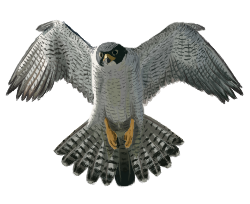
Perigrines roost and nest in cliffs. Their nests are shallow scrapes in loose soil.
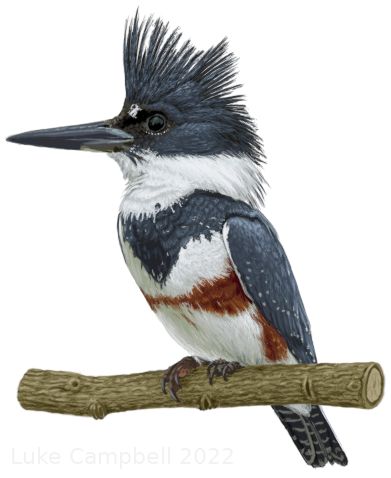
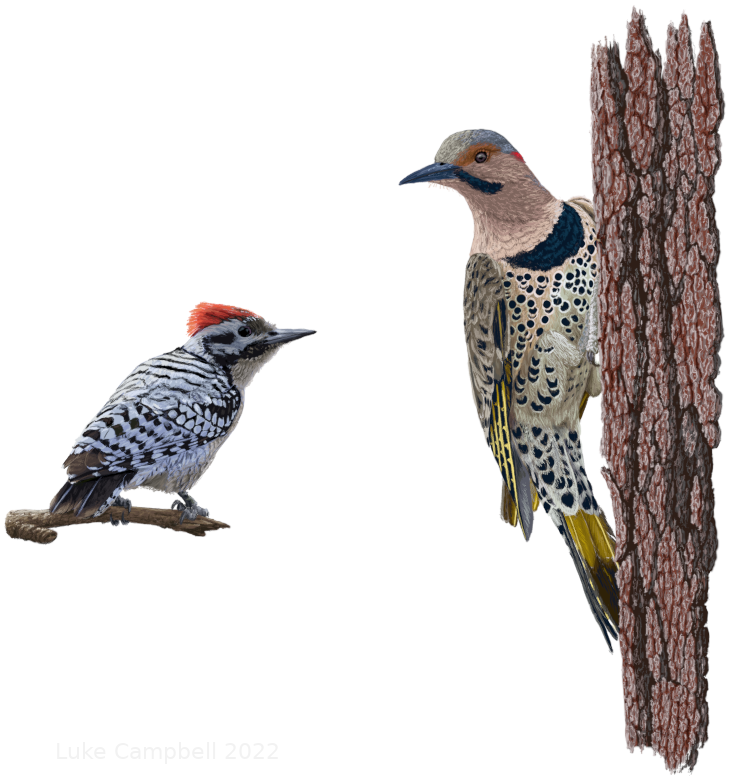
The most common of San Agustín's woodpeckers is the ladder-backed woodpecker, distinguished by its red crest and bold black and white stripes down its back. The largest woodpecker on San Agustín is the northern flicker, named for its irregular flight.
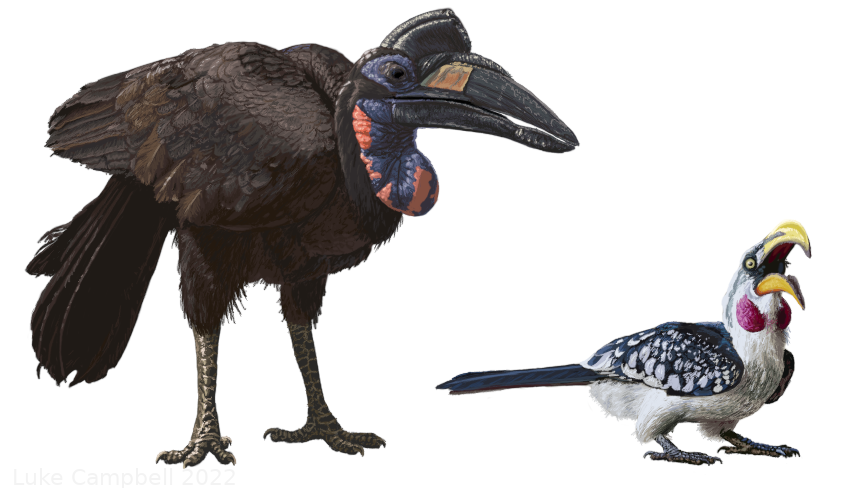
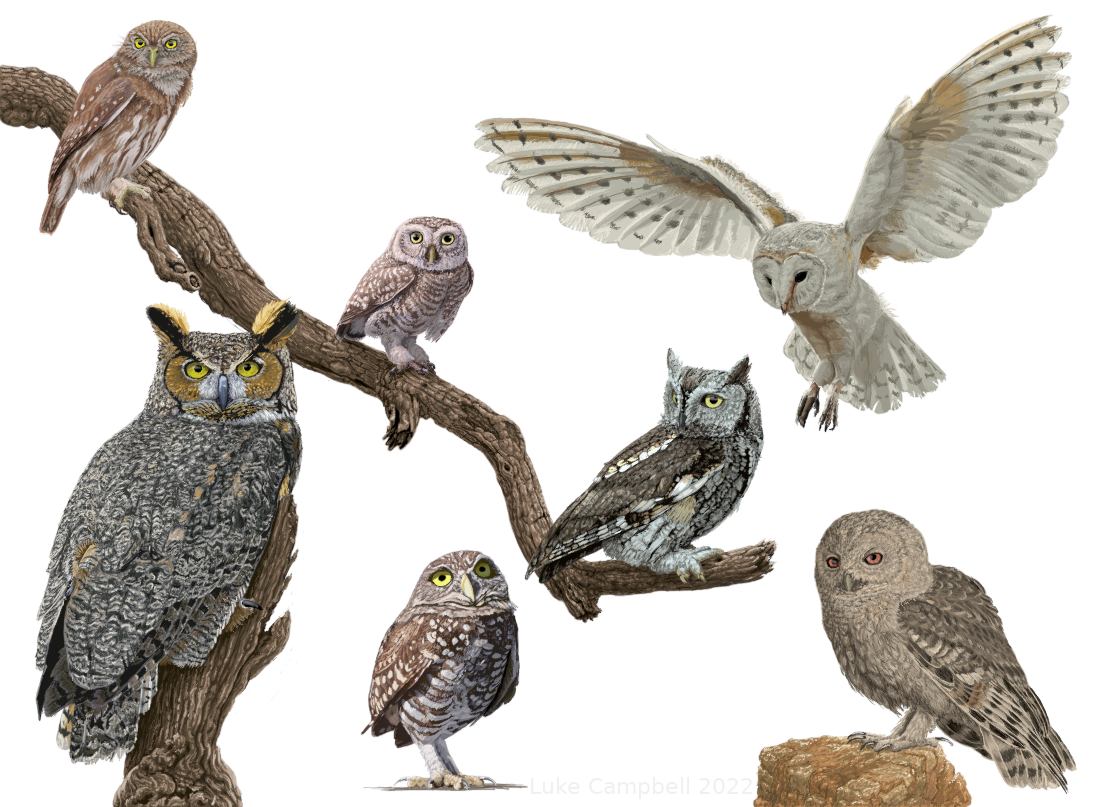
The largest of these is the great horned owl. This powerful predator takes prey ranging from mice to small dogs. They hunt at evening, night, and early morning; usually surveying the ground from a high perch. When they detect suitable prey, they descend for the kill. Great horned owls often raid the nests of other birds, even other large dangerous raptors, and are responsible for significant nestling mortality. Great horned owls are usually found near open areas where they hunt with adjacent tall structures where they perch, take shelter, and nest. These owls nest in the abandoned nests of other large birds. Barn owls are pale colored owls with distinct heart-shaped facial disks. They are nocturnal, and capable of hunting by hearing alone when in complete darkness – although they will also use their superb night vision if there is any light at all. They mainly prey on small mammals, which they catch by flying slowly scanning the ground for signs of movement. Barn owls nest in cavites, often tree hollows or fissues but commonly also old buildings such as sheds, barns, and towers. Burrowing owls are notable for being primarily active during the day. They nest and roost in burrows, generally those dug by other animals. They share their burrows with many neighbors, such as prairie dos, ground squirrels, and rattlesnakes. Unlike most owls, burrowing owls are social and live in loose colonies. If threatened, they will retreat into their burrows and make a sound like a rattlesnake. Burrowing owls spend most of their time on the ground. They have long legs for an owl, and often run their prey down. They live in open habitats with sparse vegetation. Their main food is insects and small mammals. The desert tawny owl is a fairly typical owl that inhabits dry areas with cliffs, clefts, and caves. It eats lizards, small mammals, small birds, insects, and scorpions. The western screech owl are brown or grey owls with streaky patterns providing excellent camouflage. They live in woodlands, parks, gardens, shrubland, and cactus groves. They nest in cavities of trees, cactuses, banks, cliffs, and Human-provided nest boxes. Screech owls hunt primarily insects and small mammals, although they have a diverse diet ranging from carrion to fish and even prey much larger than tey are such as rabbits and mallard ducks. The ferruginous pygmy owl is a small red-brown owl. It eats a variety of small vertebrates and arthropods. They occupy a wide range of habitats. The elf owl is the smallest of the owls. They live in scrub, desert, and open woodlands. These owls nest in the cavities of trees and cactuses. Their primary diet is arthropods, often catching large insects such as moths in flight. They commonly eat scorpions, and seem not to be bothered by their stings.
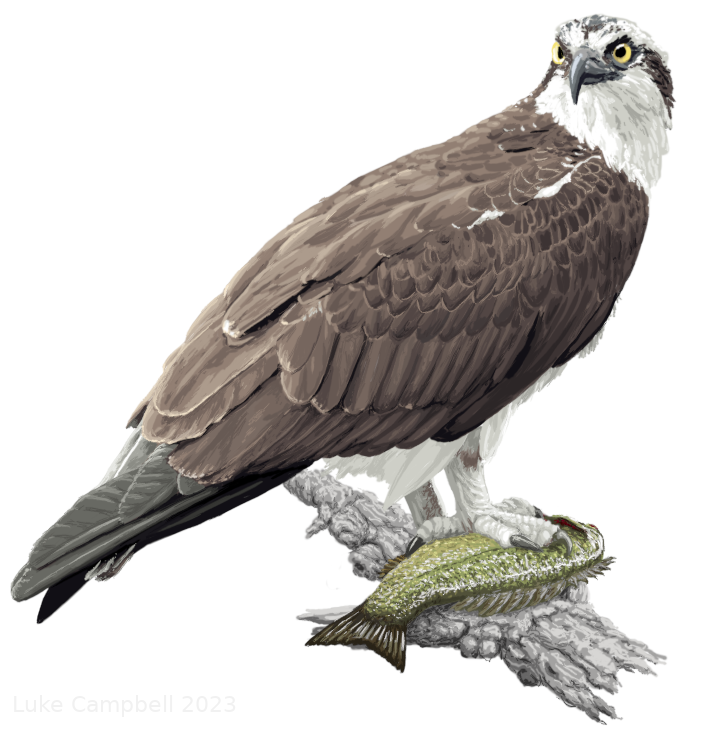
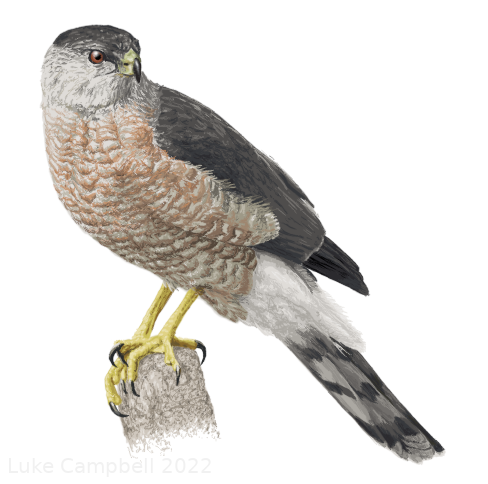
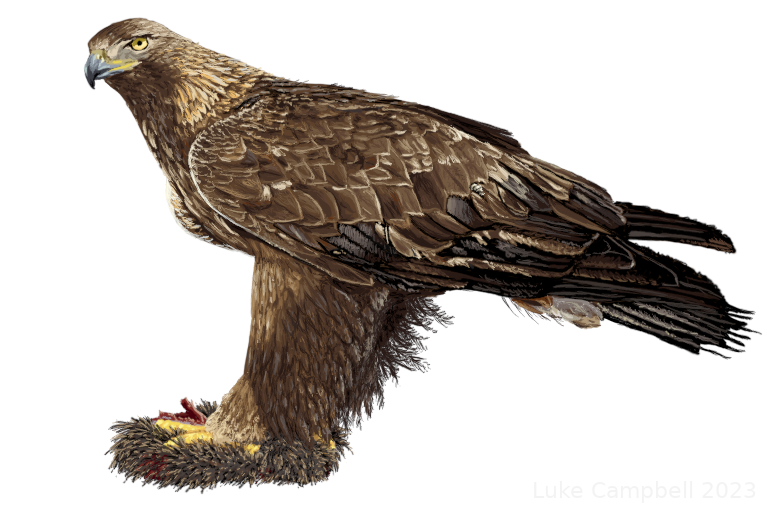
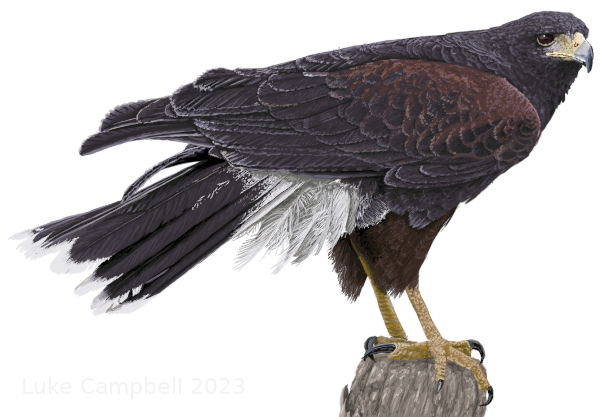
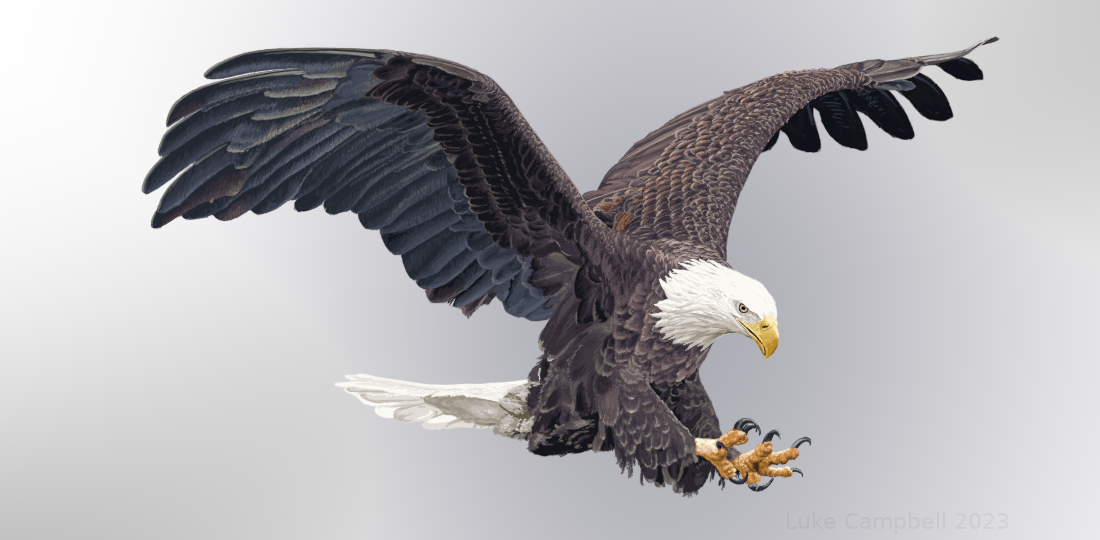
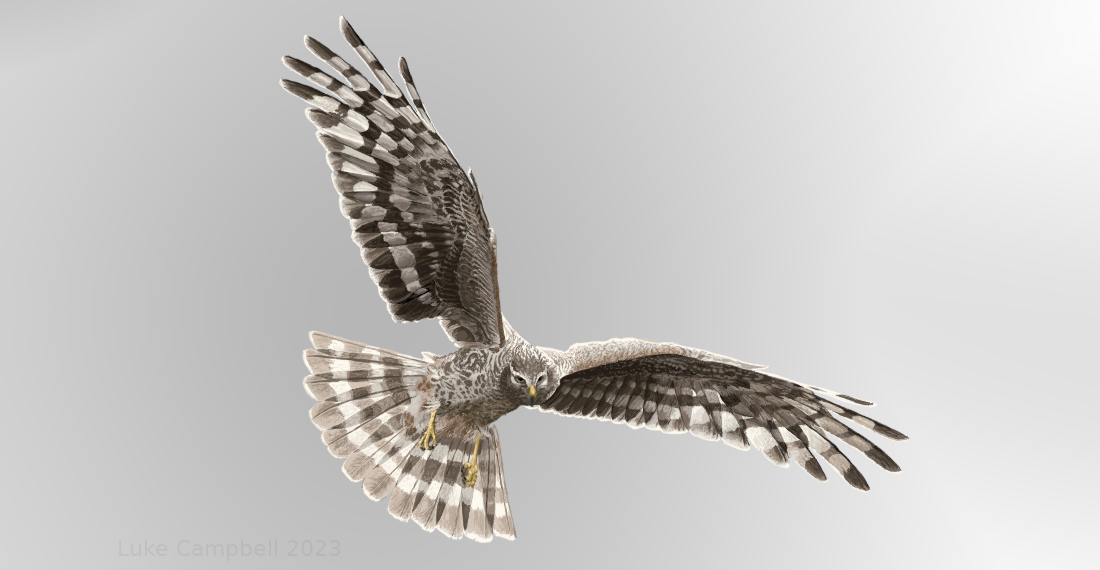
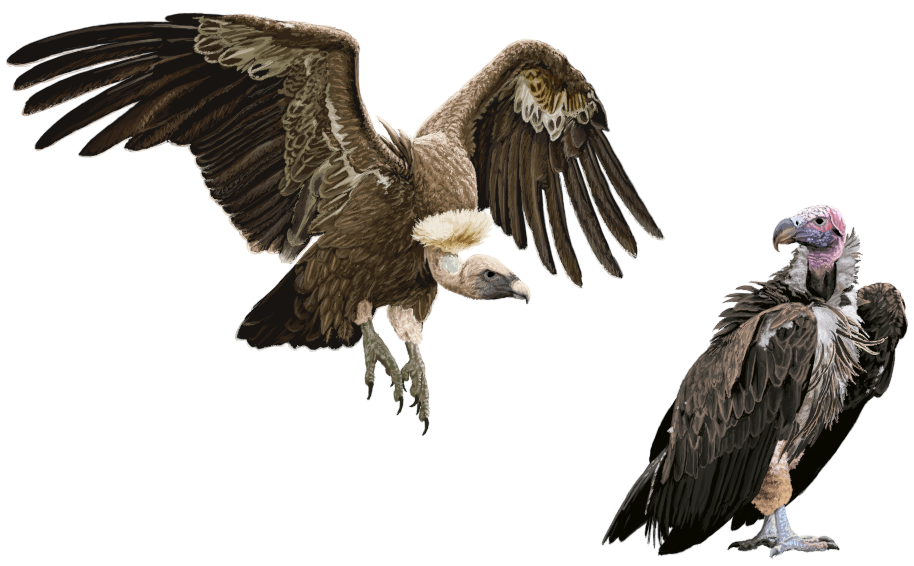
The griffon vultures specialize in eating the internal organs and softer muscle meat. They have long, flexible necks that let them stick their heads deep into a dead animal's body cavity; and mostly bare heads and necks to make it easier to keep themselves clean of gore. Lappet-faced vultures have powerful beaks for ripping in to tough food. They specialize in eating the skin, tendons, gristle, cartilage, ligaments, and other rough body parts. Other scavengers at an intact carcass often need to wait for lappet-faced vultures to show up in order to rip through the skin and open it up so everyone can feed.
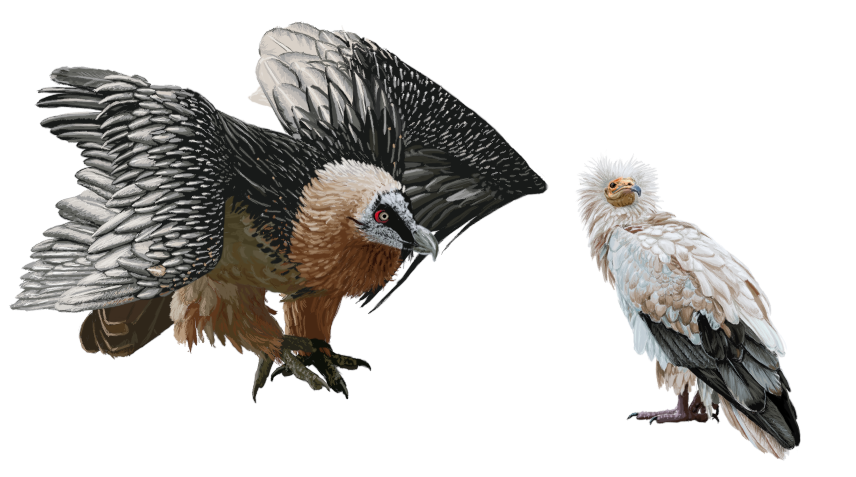
Lammergeiers are huge eagle-sized birds that fill out San Agustín's scavenger guild. They are specialized to feed primarily on bone. However, they are more predatory than most vultures and will kill animals ranging from tortoises (which they drop to break open) to goats and sheep (which they knock off cliff sides). When faced with a bone too big to swallow whole, a lammergeier will pick it up, soar high into the sky, and then drop it on a rock to crack it into more manageable bits.
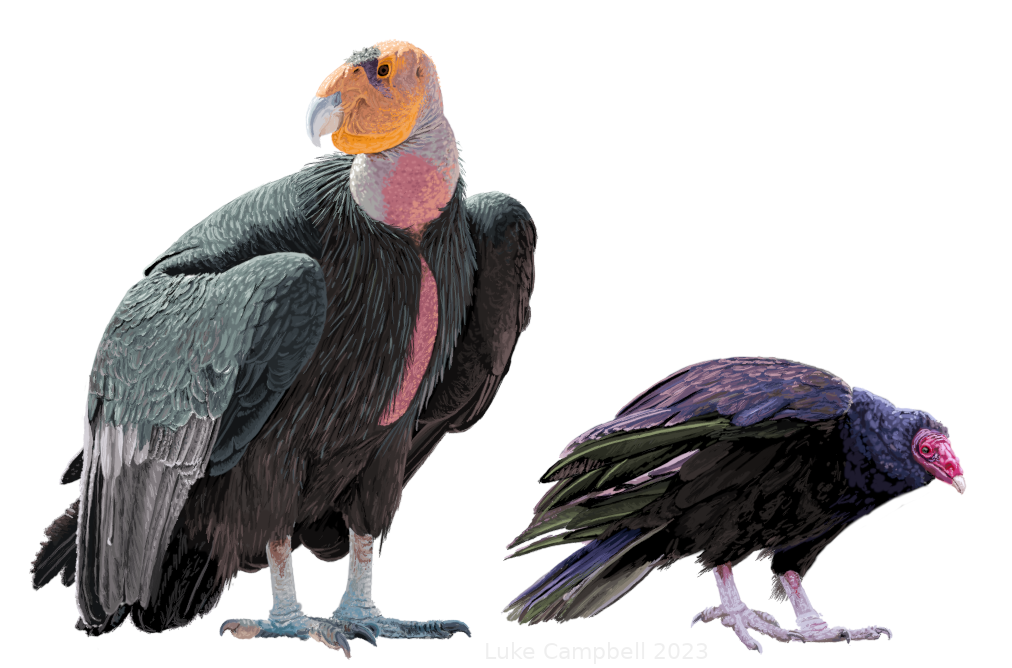
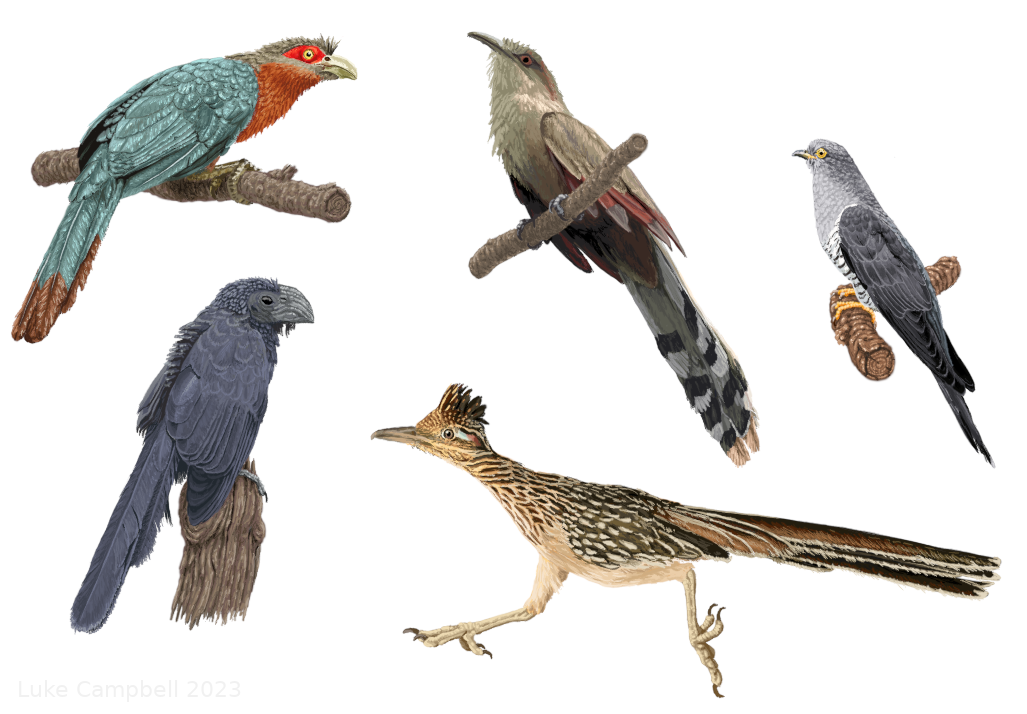
Of the pictured cuckoos, starting at top left and going clockwise, we have the chestnut-breasted malkoha, an inhabitant of tropical moist forests. This cuckoo has a fairly typical reproductive strategy, with the breeding pair constructing a nest in a tree and raising their young. The great lizard cuckoo is a large and adaptable species that inhabits a variety of tropical habitats, from scrub and savanna to forests and agricultural areas. This species likewise builds a nest and the breding pair cooperate to raise the young. The common cuckoo is a migratory species found in open land. It eats primarily insects, including various noxious caterpillars. This species is a notorious brood parasite, laying its eggs in the nests of other birds. When the egg hatches, the newly emerged cuckoo throws the other eggs out of the nest so that it may have the undivided attention of its unwitting adoptive parents. The common cuckoo's colors mimic that of smaller accipiter hawks, which might help the female to scare off nesting birds for long enough to lay her eggs. The greater roadrunner is a primarily ground dwelling cuckoo. While capable of limited flight, it prefers to walk or run – although it will fly to escape predators. It is found in hot, arid climates. In addition to the usual cuckoo diet, roadrunners are also well known for their habit of killing and consuming venomous snakes. Roadrunners are monogomous nesters who usually raise their own young, although they are occasional brood parasites. The groove-billed ani is a tropical bird of open and semi-open lands, including pastures and orchards. It feeds more on fruit and seeds than many other cuckoos, but fills out this diet with a variety of insects. Anis live in groups of several breeding pairs. They lay their eggs in a single nest, and cooperate to incubate the eggs and care for the young. This is but a sampling of the diversity of cuckoo species.
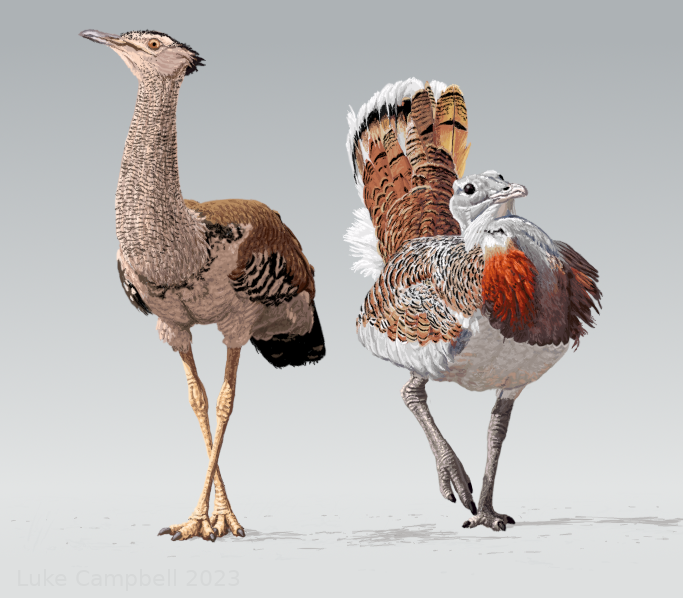
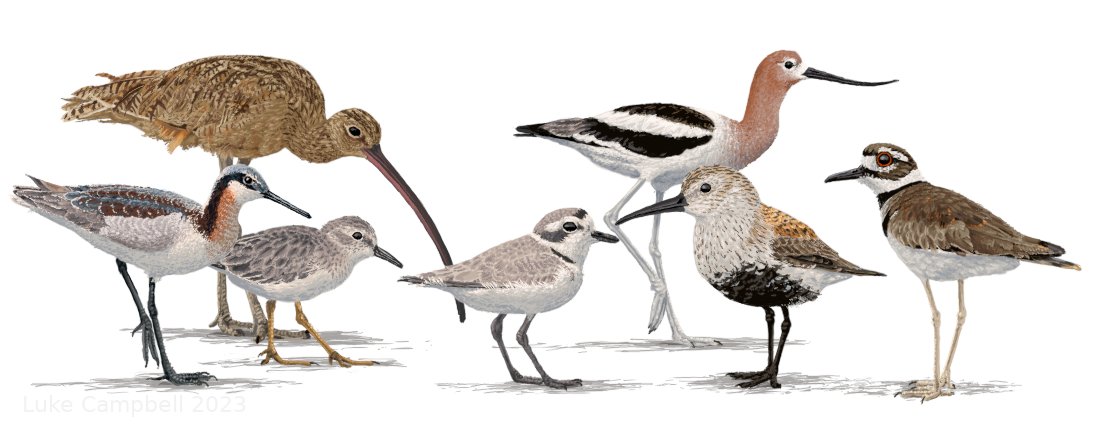
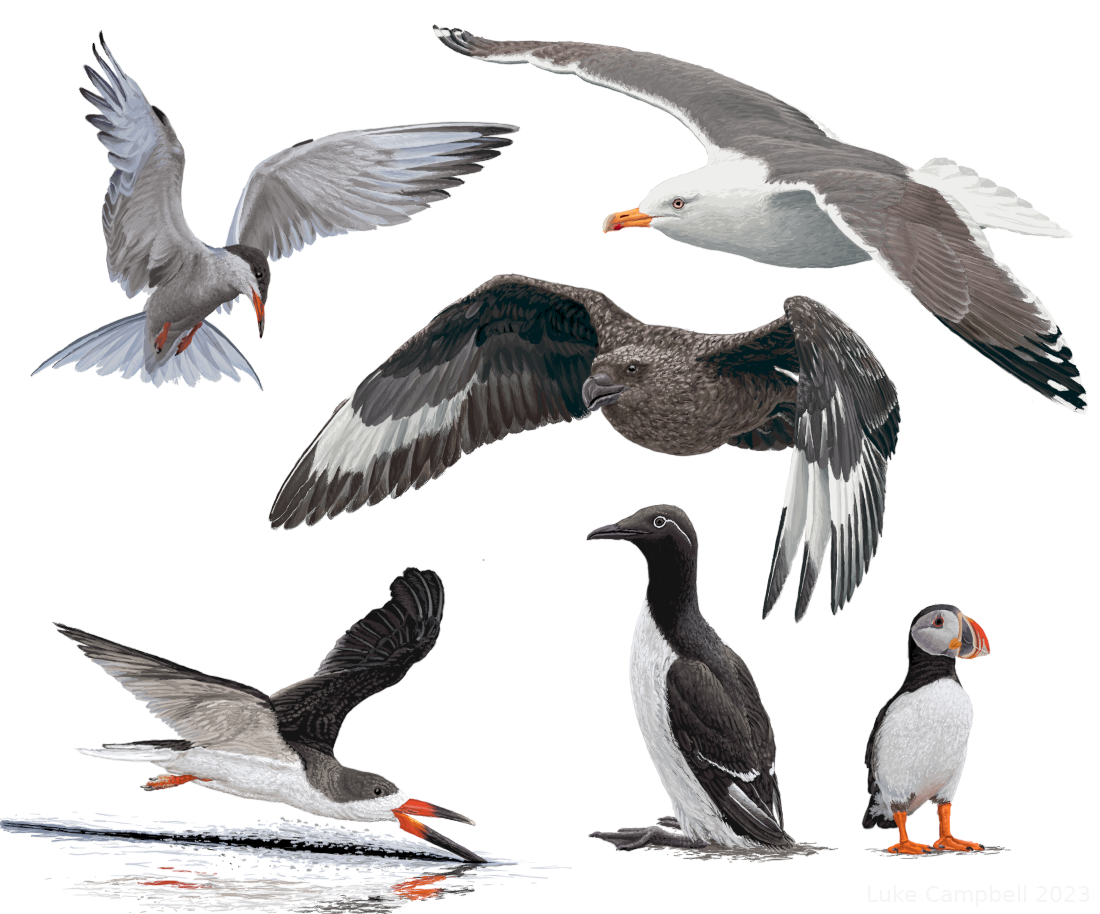
Terns are smaller lari, which commonly catch small bait fish by hovering over the water, then diving to catch their prey. Skuas are large, powerful lari. These aggressive birds will catch and eat fish, but they are as likely to predate other birds or small mammals, scavenge, or act as aerial pirates by harrassing other sea birds until they drop their catch. Skimmers are small lari with an unusual appearance for an unusual hunting technique. Their lower beaks are significantly longer than their upper beaks, and are thin and blade like. Skimmers fly just above the surface of the water with their lower beak slicing through the water's surface. When they run into a fish or other small aquatic animal, they snap their bills shut to catch the creature for their dinner. The awks are a group of diving lari, which includes the guillemots, murres, and puffins. They fly from their roosts on land out to sea, then dive after bait fish using their wings to swim.
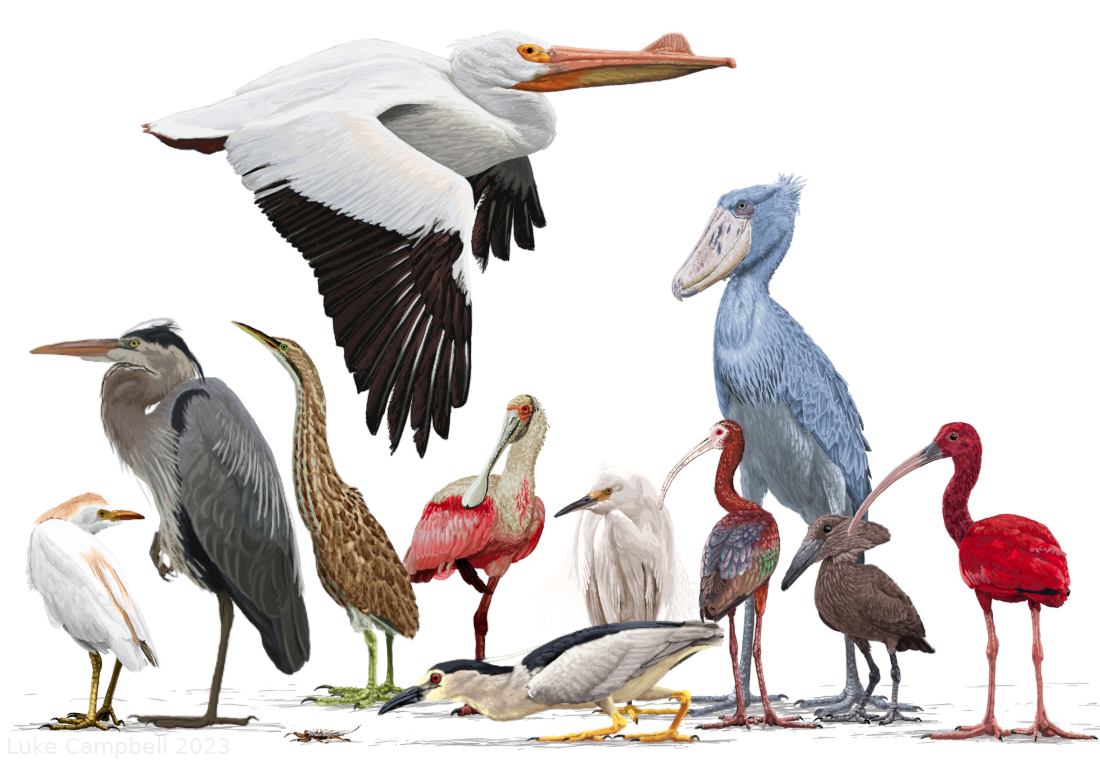
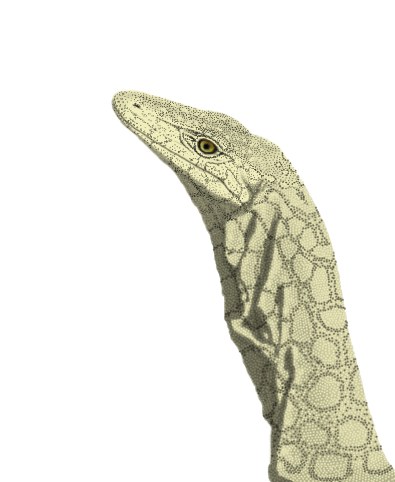
Perenties are ambush hunters, waiting prey to happen by, and active foragers, prowling their home range for opportunities. They can put on a good burst of speed, allowing them to run down prey ranging from rabbits and ground squirrels to other lizards and venomous snakes. They have a high aerobic metabolism, so they can wander far and wide in search of food, as well as letting them to keep up a chase for considerable distance. They have an excellent sense of smell, and can track prey long distances. They are also tunnel hunters, slithering down rabbit burrows after their inhabitants or digging up burrowing animals. As with many other monitors, perenties are eager to scavenge on corpses and commonly raid nests for their eggs and young. While perenties are shy around people and rarely venture close to civilization, they do have an unusual habit. When startled, they are known to run up any tall object in search of refuge. When this is a tree, it serves them well, when a fence post, less well. When the only tall object around is a standing man, or a horse and rider, a frightened perentie may well dash right up anyway, no doubt spooking the horse and giving the man quite a fright. A frightened perentie does not take kindly to being removed from its refuge, and any attempts to disentangle the lizard from one's person are likely to result in badly mangled hands from the perentie's knife-like teeth.
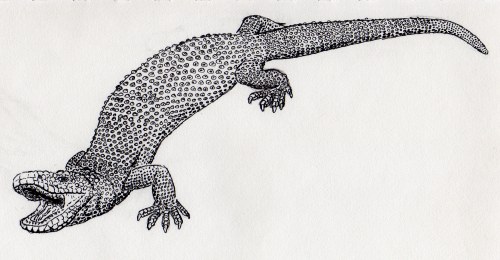
Beaded lizard venom is not needed to catch their prey, which is easily overcome by their powerful jaws; it seems to be primarily defensive in nature. When threatened, the lizard will gape and hiss, moving quickly despite their stubby appearance. If pressed to hard, the beaded lizard will clamp down with vice-like jaws. Holding on with its crushing bite, it chews to work venom into the wound. The venom flows from glands in the lower jaw along grooves in the teeth and into the flesh of its victim. The primary symptom of heloderm venom is severe pain, even agony. Even though relatively little tissue damage may be done, the victim can be incapacitated by pain. Other symptoms include localized swelling, perspiration, fatigue, and internal bleeding.
Rattlesnakes are true pit vipers, capable of sensing and hunting by radiated body heat of their prey. Rattlesnakes tend to be active in the day during cool weather, and active at night in hot weather. In temperate climates, they over-winter in rocky hibernacula, often in large groups, and disperse in springtime. Survival often requires knowledge of how to find their hibernacua - rattlesnakes transported out of their home range often cannot survive the subsequent winter. All rattlesnakes give live birth. Rattlesnakes are ambush predators. They sit coiled in one spot waiting for prey to wander by. With their cryptic patterns, they are hard to spot and they can often take their victims by surprise. The snake will lash out in a rapid strike; its long fangs, normally stored folded against the gums, will swing out to jab deep into the hapless target. In an instant, powerful muscles around the venom glands contract, injecting a dose of toxins. The rattler then releases and withdraws. The prey animal then typically runs off, saving the rattler from potential injury. A rattlesnake can smell its own venom, as the poison takes effect the rattler begins to leisurly track its upcoming meal. When it comes upon its incapacitated quarry, it will begin to eat it whole and headfirst. Snakes are unable to dismember or tear apart their meals, but can distend their jaws to a remarkable extent to swallow food of much larger girth than the snake itself. The excellent camouflage and cryptic habits of rattlesnakes also means that people walking by may not see the rattler in their path and accidentally tread on it. Directly stepping on a rattler usually means getting bit with a full dose of venom. Fortunately, rattlesnakes would rather not get stepped on, and would rather not waste their venom on something they can't eat (and leaving them vulnerable until their venom supply replenishes). When they detect something big and potentially dangerous coming toward them they usually get out of the way. If encountered at close range, they usually rattle their tails to warn off the intruder. This may be accompanied by coiling their body with the front 1/2 to 1/3 of the body held in an S-shape, ready to strike. Although usually only painful but not deadly, their bites are occasionally life threatening - or at least can result in the permanent crippling of a limb. Medical care at a well-stocked hospital within an hour of being bitten usually results in a full recovery, although the pain experineced in the meantime may make the victim wish for death until then. Rattlesnakes give live birth. Rattlesnakes will be found where there is shelter, warmth, food, and (depending on the species) water. The food the rattler is following, in turn, is attracted to its own food, plus water and shelter. Rock piles, wood piles, fallen logs, or old junk such as metal sheets or wooden planks provide shelter for both the rattler and its prey. Farmland is often particularly attractive, because the grains bring rodents to feed on, and farmers invariably leave things to hide under lying around. Bare, open areas are likely to be free of rattlesnakes.
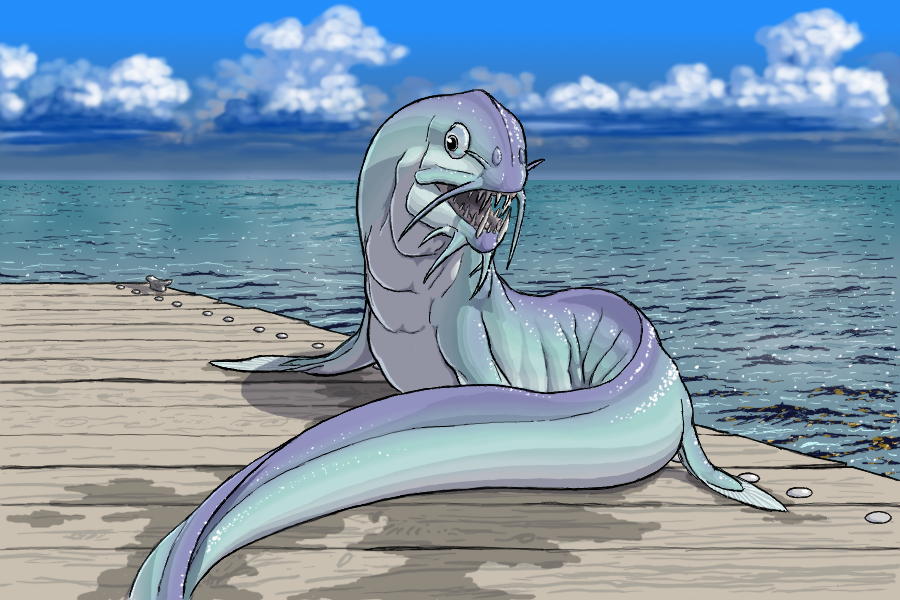
Terror eels can spend several days out of water in humid or damp conditions, and are often encountered on shore. Their ability to breathe air allows them to pass through hypersaline waters to reach refuges of brackish and moderate salinity regions. Their strong predatory instincts and large size commonly lead to attacks on sapient people. |

